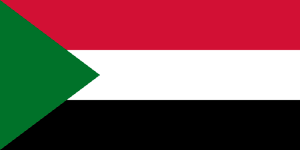
| Colors | HEX Code | RGB | CMYK |
|---|---|---|---|
| Red | #D21034 | 210, 16, 52 | 0, 92, 75, 18 |
| White | #FFFFFF | 255, 255, 255 | 0, 0, 0, 0 |
| Black | #000000 | 0, 0, 0 | 0, 0, 0, 100 |
| Green | #007229 | 0, 114, 41 | 100, 0, 64, 55 |
The flag of Sudan has three equal horizontal stripes. The top stripe is red. The middle stripe is white, while the bottom stripe is black. A green triangle is at the hoist side of the flag.
Meaning of the Flag of Sudan
Black is associated with al-Mahdi, the Sudanese leader who freed Sudan from British and Egyptian rule. It also refers to the name of the country itself which refers to black, honoring Sudan’s African heritage. White refers to the flag of revolution adopted in 1924. It also symbolizes peace and optimism. Red represents the martyrs of independence, socialism, and progress. Green is a symbol of prosperity, agriculture, as well as of the Islamic religion, to which a majority of the inhabitants adhere. Green represents prosperity and the Islamic religion, which is the religion of the majority of Sudanese.
History of the Flag of Sudan
The Egyptians together with the British administered Sudan in the late 19th century. Then Al-Mahdi, who was a religious leader, led a rebellion against the British and the Egyptians. In 1899, Britain and Egypt regained their role in Sudan. While the British and Egyptian flags were flown, the Sudanese expressed their rebellion against the British and Egyptian rule by raising plain white flags. In 1956, the Sudanese could hoist their national flag which was a tricolor of blue, yellow, and green. In 1970, a flag with the Pan-Arab colors was raised.